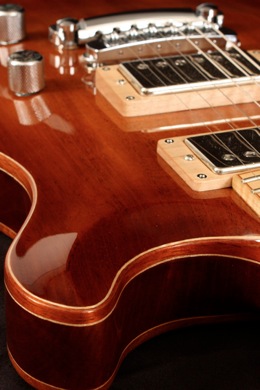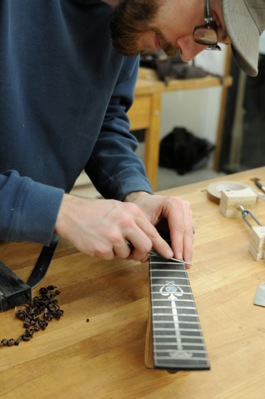ABOUT SNIDER GUITARS
The Guitars:

I am dedicated to building the finest handmade guitars possible. This means three main things to me: tone, playability, and aesthetic. If a Snider guitar lacks any of these things, it is a failure in my mind. The guitar has to achieve its fullest tonal potential, first and foremost. But a great sounding guitar isn't much good if it's not playable; if it's not a guitar you don't want to put down; if it doesn't become one with you when it's in your hands. I also think a guitar should be something beautiful that begs you to pick it up in the first place - its design, shape, and contours inspiring you to create music.
In my opinion these things are only achievable through a total dedication to the highest level of craftsmanship possible, through an innate passion for the craft, and through a deep understanding of how all the individual parts of a guitar work together. The voice of a guitar is the sum of its parts. The body, the neck, the fingerboard, the headstock, the pickups, the bridge, the truss rod, the hardware, the pots, the glue, the finish - everything working together.
I don't farm out any work to other builders or apprentices, and I don't have any CNC machines. Not that CNC machines aren’t cool and don’t have their place; it’s just not how I want to do it. I don’t want to be a small factory. I build with a combination of traditional and modern techniques, and prefer using hand tools whenever possible. My electric guitars are cut out and shaped freehand. My tops are carved by hand. My necks are all hand carved and shaped, and I install frets the old fashioned way with a fret hammer. I also do all of my own inlay and finish work.
And to clarify, to me, building a guitar "by hand" doesn't mean there aren't any power tools used; it means my hands are controlling and guiding whatever tool is used. Again, however, I do prefer hand tools to power tools whenever feasible. My goal is to make the best guitars I can make, not the most money.
The Guy Who Builds the Guitars:

There has never been anything else in my life (besides my wife and children) that has captured my attention and enveloped my soul like guitar building has since the moment I became aware of it. As a teenager, I quickly learned how to mod my guitars and do simple repairs, and learned more repair and setup skills working in a local music shop. But I didn't really understand that guitars could be made by individual human beings. I thought they all came from big factories.
When I was shaken from my ignorance and discovered the notion of luthierie, I was IN. I finally knew what I was meant to do. I loved guitars, and I had always loved making things and was fortunate to be good with my hands. So I jumped all the way in.
I bought books, I poured over forums, and I took a weekend woodworking course. I called every luthier in town, and was lucky enough to find one who would take me on as an apprentice. I learned how to build electric guitars there with Bruce Clay. At the same time, I got a job at a furniture restoration shop and built on my fine woodworking and finishing skills. Eventually I apprenticed with Brian Deckebach of Del Toro Guitars as well, and soon I found out about an acoustic guitar building program right in town, taught by none other than Robbie O'Brien. After studying with him for a couple semesters, I became his assistant and eventually created the electric guitar building and inlay classes at Red Rocks School of Fine Woodworking and Lutherie. For seven years I helped hundreds of students build electric and steel string guitars, and taught fine woodworking and inlay to many more.
In 2012 I left Red Rocks and Colorado to move with my family to beautiful Upstate New York. It is here that I continue my craft and do what I love.
